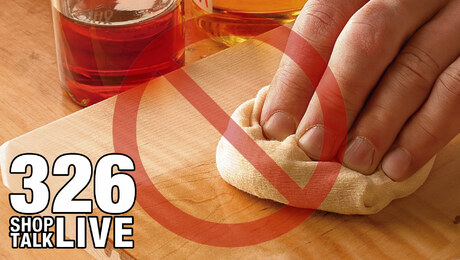STL 157: The Tale of Professor Frid
Bandsaw speed settings, mitered rips by hand, cabinet scrapers, crosscut sleds, sliding dovetails, and all-time favorite articles and toolsThis episode is brought to you by Furniture Medic
03:20 – Question 1:
In episode 62 (sorry Damien, looks like 59 to me -Ben), Rollie Johnson off-handedly advised a listener that by using the slower setting on his band saw he could cut nonferrous metals. This got me thinking about my band saw’s speed options and forced me to realize that I haven’t thought much about my selection since initially setting up the saw years ago as a neophyte. I can remember thinking at the time that the slower speed might be safer for a new user. Am I wasting time by not putting my band saw on the faster speed when making most cuts in wood, and what effect, if any, does the speed have on cut quality and safety? -Damien
06:55 – Question 2:
Last July I began working on a 2-year project in Suriname South America. Lots of exotic wood here but not many woodworkers. I was unable to pack my well stocked, power-tool-rich workshop so I undertook the adventure deciding to become at least familiar with hand tools. I have been focusing on boxes because they don’t take much material and there is good information and instruction available. I have not been able to figure out the best way to rip an accurate 45-degree miter cut by hand. I understand how to execute mitered corners it’s the mitered rip that has me puzzled. Typically, the cuts would be no longer than 10 inches. Please advise before I import a table saw. -Gray
10:10 – All-Time Favorite Article of All Time… for this week
- Anissa – Professor Frid by Hank Gilpin (Issue #146 – 2001)
- Mike – Understanding Wood Movement by Christian Becksvoort (Issue #165 – 2003)
- Tom – Beautiful Bandsawn Boxes by Michael Cullen (Issue #250 – 2015)Video Workshop – Make Beautiful Bandsawn Boxes
21:45 – Question 3:
I have a #80 scraper. I have never been able to get it to work, even though I have read over the sharpening instructions many times, which describe a pretty standard process for sharpening a scraper. However, when I take the blade out of the handle, it is the best scraper I own. I assume this is because I can hold it at a higher angle and the thick blade has no flex. What am I missing to make this scraper work the way Stanley intended it to? -Michael
25:00 – Question 4:
I have started planning out some basic shop jigs and fixtures, including a crosscut sled for the table saw, and a shooting board for the bench. Most plans that I find for these items have fences that are fixed (i.e., glued and screwed down). This seems daunting to me, since if I don’t get it perfect during the build, they will be useless and I will have to start over. Likewise, if anything comes out of square through use, it will also become ruined. What are your opinions on making jigs fixed versus adjustable? -Stephen
28:40 – All-Time Favorite Tool of All Time… for this week.
- Mike – Wire brush for burnishing wenge
- Anissa – Infinity SawStop Zero Clearance Throat PlateShopmade Tablesaw Inserts by Bob Van Dyke
- Tom – 5″ Random Orbit Sander
44:58 – Question 5:
As part of her booth at a craft show, my wife asked me to produce two pieces of wood that could be joined together end to end and then pulled apart for transport. I chose to do this using a sliding dovetail. I did it on the router table but the problem I had was that on both the male and female parts, although one dovetail cut was normal, the other side had to be a climb cut. I got away with it after some cleaning up but the climb cuts were more “exciting” than I would have liked. Could I have made this joint a different way or was it dumb to even try? -Graham

 |
 |
 |
| Tom McKenna Editorial Director |
Mike Pekovich Creative Director |
Anissa Kapsales Associate Editor |
Every two weeks, a team of Fine Woodworking staffers answers questions from readers on Shop Talk Live, Fine Woodworking‘s biweekly podcast. Send your woodworking questions to [email protected] for consideration in the regular broadcast! Our continued existence relies upon listener support. So if you enjoy the show, be sure to leave us a five-star rating and maybe even a nice comment on our iTunes page.




















Comments
Without getting too crazy, it would seem to me a tight-fitting and pegged bridle joint suffice for the end-to-end joint, as long as the pegs were a tight friction fit...
Mike mentioned a wire brush use on hardwood and referenced an article in “Jindozuki” (sp?). Do you have a link to that article?
On the wire brush question, jin di sugi is the name. Search it up in the bar at the top of the FWW site and you'll see it. As best I can figure, it means something along the lines of "the affliction of cedar"--probably referring to the original technique of letting it rot.
For the craft-show booth, +1 on the bridle joint. Some kind of thumb screw into a threaded insert would be more convenient than a peg. I would also consider a countertop connector like ZipBolt or similar. Depends a bit on what is and is not visible. Not sexy woodworking, but as a person who has designed and built many trade show and similar displays, ease of use is key if it does not detract from the appearance to an unacceptable degree.
I added a link in the show notes above. I meant to before posting, and it somehow never made it in.
Log in or create an account to post a comment.
Sign up Log in